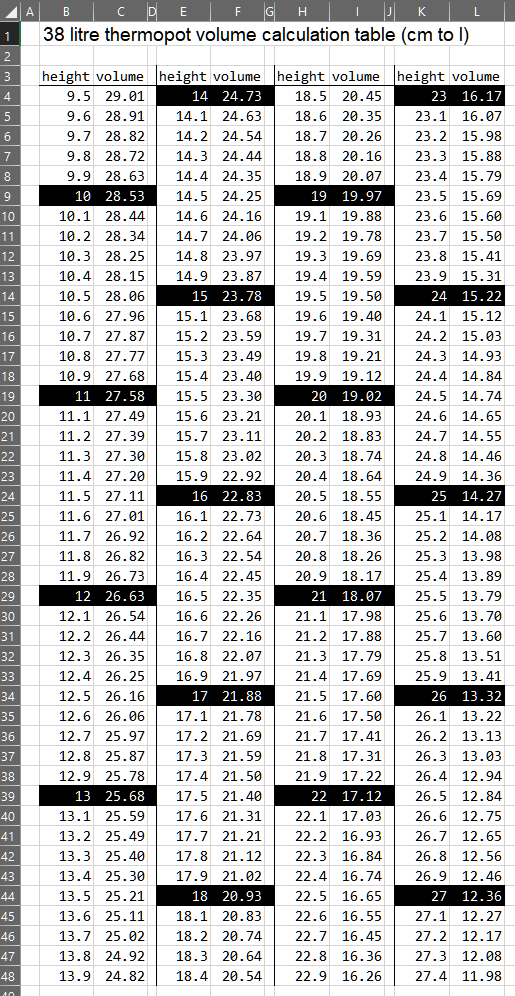Update: AG#23 Bitsa SCA
Well after all my recent starter building I've actually brewed something more intersting to write about! Honestly I've no idea what style this fits - it's a user upper bitsa this, bitsa that, something like bitter/APA/IPA/or maybe Amber Ale, it seems a bit darker to me than Brewer's Friend predicted. Ah, whatever, it'll hopefully be beer of some sort!
Inspired by "Simple Homebrewing" by Drew Beechum & Denny Conn, I wanted to shorten and simplify my brew day with:
(a) Full volume mash / No sparge
(b) 30min mash
(c) 30min boil
This was planned very much as a fact finding brew - how would quite radical changes to my process affect my numbers and the length of my brew day?
1160g MO
540g lager
300g Munich
200g Belgian biscuit
200g Vienna
200g FB
90g CaraMunich 1
I added half a campden tablet when i heated my water, along with 2g gypsum and 5ml lactic acid (80%) and a good stir.
Full volume mash - that's right baby, no sparging for me!
I heated 14 or 15L water in my new tea urn - the marks on the urn said 15L but I'm not convinced, i think it was actually more like 14L
35min mash at 64degC - after a full on monster bag squeeze I had 13L in the brew kettle (hence why i don't believe i really had 15L to start with!)
30min boil:
4g Citra + 9g Simcoe for 30 mins
10g Simcoe for 10 mins
10g Citra for 5 mins
10g Amarillo at flameout
(About 42 IBU's in total)
BG 1.042
OG 1.047
Pitched Wyeast 1056
I cooled to 20degC with my immersion chiller - but as with my last brew i left it to stand a few hours while the hop trub and gunk settled out. Then i syphoned 9L crystal clear wort to the FV and pitched my yeast starter - the aim of this is to try to get clearer beer and no chill haze by not transferring all this crud and cold break material to the FV.
I also collected 3L of crud - this has settled out overnight and netted me an extra 1L clear wort which I added to the FV today.
So what are the conclusions so far?
Having one big urn to heat all my water in one go is SO easy compared to heating it 2L at a time in 2 x kitchen kettles! As well as being less faff it also seems pretty quick. If this is anything to go by, I really want to go electric for the boil now!
I don't think the water level marks on the urn are very accurate, and nor is the temperature knob - but these are easily dealt with next time, forewarned is forearmed.
My efficiency took a dive - down from typically around 78% (consistent across 20 brew or so) to 66%. That sounds a lot but according to Brewer's Friend it's only about 5 or 6 gravity points.
But for me it's totally a price worth paying - I can compensate next time with a bit more grain, and no sparge / full volume is so much less hassle. That alone probably saved me a bunch of time. Coupled with the shorter mash and boil times i reckon i knocked 90 minutes of my brew day - if only i could say the same about cleaning up afterwards!
One side effect of no sparge is that the wort temp is lower at the start of the boil - but in practice this didn't seem to have a significant impact on the time taken to raise the wort to a rolling boil.
A 30 minute boil means i need to add more bittering hops - but i don't think there's a huge difference between 60 or 30 mins. Also at these volumes I only use a few grams of bittering hops anyway - i have more of a problem with left overs to be honest!
The jury is still out on whether it makes a difference to let the crud settle and then syphon the wort a few hours later. Having already bottled one batch like this it certainly means you get much cleaner yeast if you harvest it - time will tell though if it actually solves my chill haze problem!
In short:
Full volume mash / No sparge - yes!
30 min mash - yes!
30 min boil - yes!
Cheers,
Matt






















































